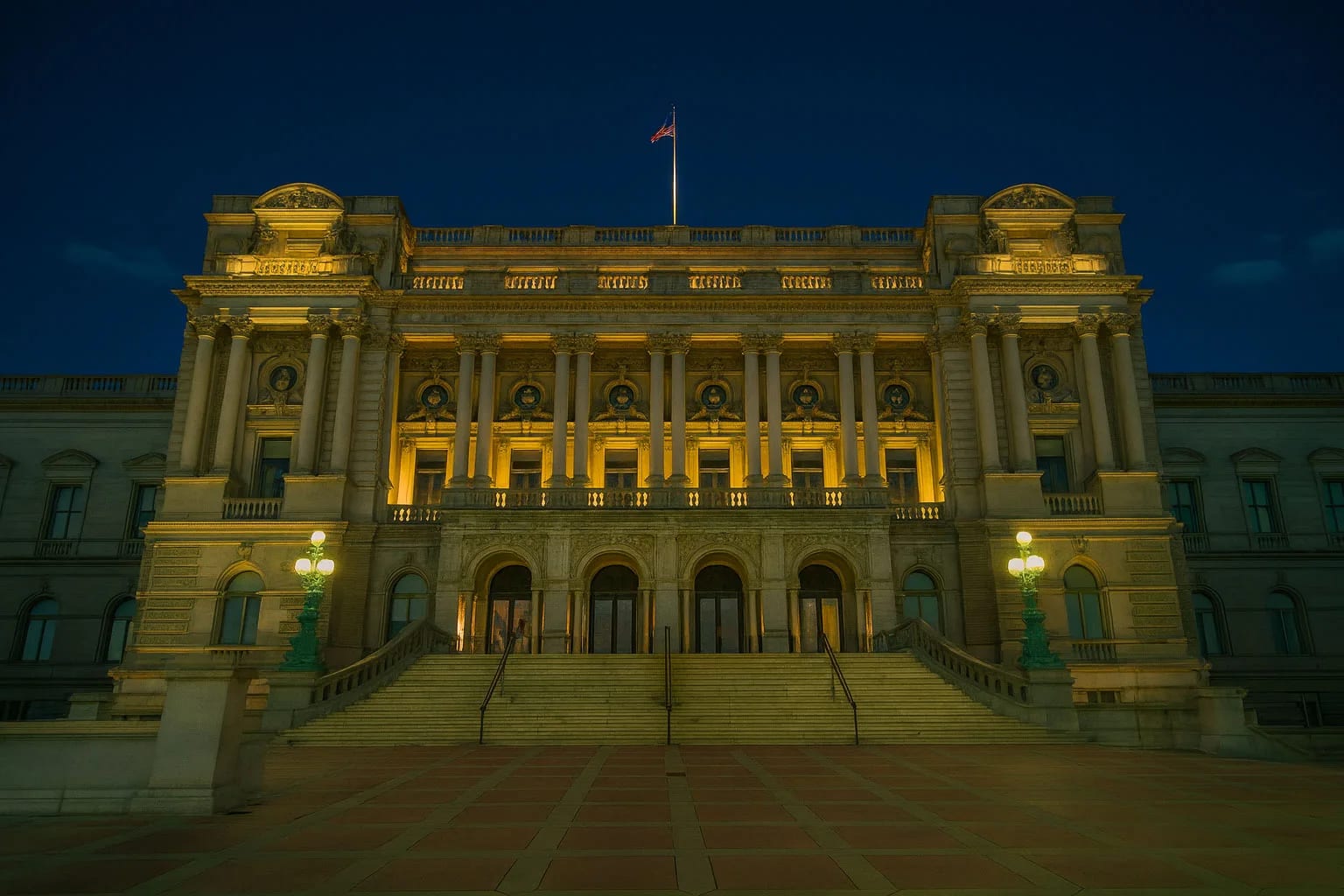America's Haunted Cathedral of Knowledge
The Library of Congress stands as a monument to human knowledge - 838 miles of bookshelves, 173 million items, and the collective wisdom of centuries. But within its magnificent halls, time operates differently. Scholars who died decades ago still turn pages. Librarians long deceased continue their cataloging duties. And in the quiet hours, when living researchers depart, the true inhabitants of the library emerge. This is not a haunting born of tragedy or violence, but something more profound - the refusal of devoted minds to abandon their life's work. In death, as in life, these spirits seek knowledge, their eternal research continuing in spectral form.
A Library Built on Ashes
The First Library Burns
The original Library of Congress, housed in the Capitol, contained 3,000 volumes when British troops set it ablaze during the War of 1812. The destruction of knowledge left a psychic scar - some believe the anguish of lost wisdom created the library's first hauntings. Staff report seeing phantom flames in areas where the original collection stood, and the smell of burning paper where no fire exists.
Jefferson's Collection
Thomas Jefferson sold his personal library - 6,487 books - to replace the destroyed collection. His obsessive love of knowledge and meticulous organization habits may have imprinted on the building. The ghost of a tall man in 18th-century dress is seen in the Jefferson Building, carefully examining books and appearing disappointed when they're out of order. Some believe Jefferson himself returns to ensure his beloved books are properly maintained.
The Second Fire
In 1851, another devastating fire destroyed 35,000 books, including two-thirds of Jefferson's collection. The loss of irreplaceable knowledge created another layer of spiritual trauma. Researchers report that on December 24th (the fire's anniversary), the library becomes thick with the scent of smoke and the sound of distant crackling - a psychic echo of knowledge consumed by flames.
The Grand Building
The Thomas Jefferson Building, opened in 1897, was designed as a temple to knowledge with elaborate murals, sculptures, and the magnificent Main Reading Room. The building's beauty and reverence for learning created an atmosphere where scholarly spirits feel welcome. The architecture itself seems to invite eternal study - and many have accepted that invitation.
The Eternal Scholars
The Phantom Librarian
The most frequently encountered spirit is an elderly librarian in period dress from the early 1900s. Staff recognize her by the distinctive high-collared dress and severe bun. She appears primarily in the stacks, methodically shelving books that researchers have left on tables. When approached, she continues her work, seemingly unaware of or unconcerned with living observers. Books she touches often fall open to exactly the page researchers need - as if she's still helping patrons find information even in death. Security footage has captured books returning to shelves on their own, moving through the air in the deliberate, careful manner of someone trained in library science. The pattern matches human shelving behavior perfectly - except no human hands are visible.
The Eternal Readers
In the Main Reading Room, witnesses report seeing translucent figures seated at desks after closing, intently studying books that cast no shadow. These phantom scholars appear in period dress ranging from the Victorian era to the mid-20th century. They seem absorbed in their research, taking notes with invisible pens, turning pages that make no sound. One recurring spirit is a young woman in 1920s attire, always at the same desk, eternally working on what appears to be a dissertation she never completed. Psychics who have encountered her claim she died suddenly of Spanish Flu, and her unfinished work keeps her bound to the reading room. She appears most frequently during exam seasons, as if drawn by the anxiety of living students.
The Stack Wanderer
Deep in the miles of book stacks, a male figure in Civil War-era clothing roams endlessly, as if searching for a specific volume he can never find. He appears solid until witnesses try to speak with him, at which point he vanishes mid-stride. Staff have nicknamed him 'the Searcher' and report that his presence is often announced by the sound of footsteps in empty aisles and the rustle of pages in books no living person is touching. Some believe he was a researcher studying the Civil War who died before completing his work. Others suggest he's searching for documentation of his own service, seeking to correct historical inaccuracies about his regiment. His searching is desperate, urgent - suggesting whatever he seeks holds profound personal importance.
The Children in the Children's Reading Room
The Nancy Hanks Center houses a children's library where small phantoms appear during story times. Librarians report seeing translucent children sitting cross-legged on the floor, listening to stories being read. These spirits seem happy, not frightening - child readers who loved books so much they continue visiting even after death. The ghost children never interact with living children but have been photographed numerous times, appearing as Victorian-era youngsters in old-fashioned clothes. Some wear what appears to be orphanage uniforms. Their presence is considered benign and even comforting - a reminder that love of reading transcends even mortality.
Documented Phenomena
The Midnight Catalogers
Overnight security staff report hearing the distinctive sounds of library work during their rounds - the click of card catalogs (despite the library being computerized), the stamp of date cards, the squeak of book carts. When they investigate, the sounds stop, but items have been mysteriously reorganized according to older cataloging systems no longer in use. Books requested through the library's system sometimes arrive at patrons' desks without any living librarian having retrieved them. Security footage shows books sliding off shelves and floating through the stacks, moving with purpose toward waiting researchers. Staff have learned to thank the 'ghost librarians' who continue their helpful service beyond death.
The Reading Room Anomalies
The Main Reading Room, under its magnificent dome, exhibits the most concentrated paranormal activity. Researchers report: - Sudden temperature drops at specific desks, always the same locations - The sensation of someone reading over their shoulder - Invisible hands helping them lift heavy reference volumes - Books opening to exactly the pages they need without being touched - Whispered recommendations for additional sources in archaic language - The overwhelming presence of countless unseen watchers Photographs taken in the Reading Room often show orbs, light anomalies, and occasionally full spectral figures that weren't visible when the picture was taken. The density of paranormal phenomena increases during the library's busiest hours, as if the ghost scholars are energized by the presence of living researchers.
The Rare Book Room
The Rare Book and Special Collections Reading Room houses priceless manuscripts and first editions - and apparently, their most devoted admirers. Curators report that certain valuable books seem to resist being misshelved, returning to their correct location overnight. Security cameras show books moving on their own, but always carefully, with reverence. The ghost of an elderly scholar in early 20th-century formal dress appears near the medieval manuscripts, carefully turning pages as if checking for damage. When approached, he continues his examination, muttering in what linguists identify as Middle English. Some believe he was a medieval studies professor who spent his life studying these exact manuscripts and cannot bear to leave them unprotected.
Experiencing the Haunted Library
The Library of Congress is open to the public, though access to certain areas requires researcher credentials. The Thomas Jefferson Building, with its stunning architecture and Main Reading Room, is the most accessible and most actively haunted location. For paranormal experiences, visit during quieter periods - early mornings on weekdays or late afternoons. The ghost scholars seem most active when living crowds thin, as if they prefer peaceful study conditions. The Main Reading Room allows visitors to observe from the gallery above, offering a perfect vantage point to watch for spectral researchers. The hallways between the three buildings (Jefferson, Madison, and Adams) are connected by tunnels where staff report frequent ghostly encounters. These utilitarian spaces, away from public view, seem to be favored by the phantom librarians who continue their eternal maintenance duties. Library staff have a respectful relationship with their ghostly colleagues. They've learned not to reshelve books too quickly if they find them mysteriously moved overnight - the ghost librarians usually have good reasons for their reorganizations. Researchers who acknowledge the helpful spirits often report increased success finding obscure sources, as if the library's permanent residents assist those who show proper respect. Visitors should approach the Library of Congress with reverence for both its living collections and its spectral inhabitants. This is not a place of fear or tragedy, but of eternal scholarship - where the pursuit of knowledge proves stronger than death itself.

